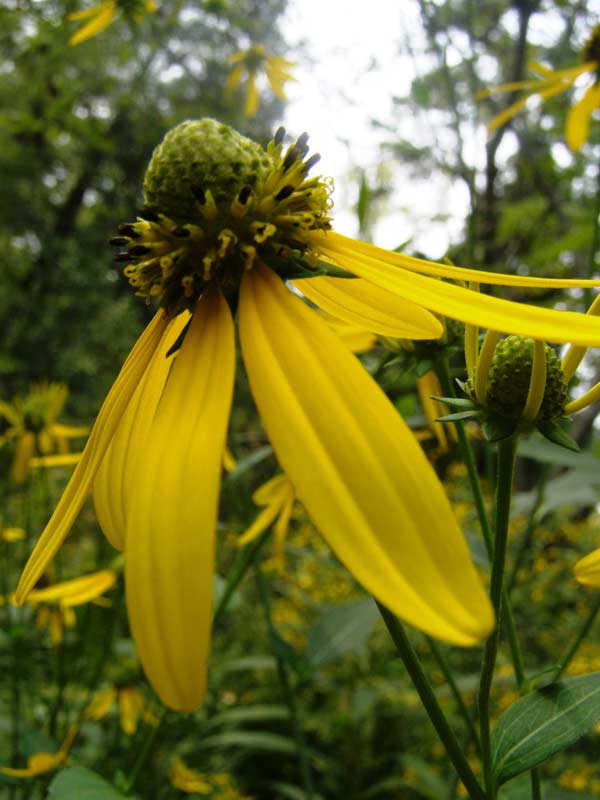In a shooting star-like pose, the golden ray flowers point down from the greenish central cone of the green coneflower.
By Ken Moore
I had something totally different planned for this week until I visited the opening of the Botanical Garden’s 20th Anniversary “Sculpture in the Garden†show. If you have never visited this annual show, be certain to treat yourself to at least one visit there between now and mid-November!
Down in the area in front of the Paul Green Cabin, I was totally blown away by the psychedelic exuberance of masses of green coneflower, Rudbeckia laciniata. I’ve always enjoyed seeing a clump or two here and there, but to see so many in full flower … well, it was like I had died and gone to heaven!
This plant, another one of those numerous members of the Aster or Composite families, is a close relative to the better known Black-eyed Susans, all of which bear the same generic Latin name, Rudbeckia. All of these have yellow ray flowers. However, the central cone of disc flowers of the green coneflower is greenish in contrast to the dark-brown center of the several Black-eyed Susan Rudbeckia species. Another common name is cutleaf coneflower. This appropriately descriptive name calls attention to the fern-like foliage along the lower portion of the stem. In the late winter and early spring the fernlike, lush, dark-green basal foliage is an attractive accent in the woodland garden as well as in a carefully managed perennial border. The six-foot-tall flowering stems are generally found along stream banks and wet ditches throughout the Piedmont and mountains and occasionally all the way down to our coastal counties
during the late summer and early fall.
In addition to a number of medicinal uses, the tender spring foliage of the green coneflower has been described by the Cherokee as a flavorful spring tonic green.
Like most any plant, the Green coneflower prefers sunlight. Plants we generally recognize as shade plants are really not shade-preferring plants; rather, they are shade-tolerant plants. That is, though thriving in full sunlight, they can be content in shady areas, but may not flower as profusely. Green coneflower is a perfect perennial for the garden lover always searching for a shade-tolerant plant that will provide vivid flowers in the late summer. I can recall being drawn back to the interior of a deeply shaded woodland garden during this time of year by the golden glow of the green coneflowers on just one or two plants. So there you have it, an easy-to-grow perennial wildflower for sun or shade.
Visit the Botanical Garden soon to see those masses of coneflowers before they go, and while there take in the sculpture show and look for green coneflowers on the plant-sale bench. There will certainly be some available at the garden’s big native plant sale coming up on Saturday, September 29.

The lower stem leaves of green coneflower are fern-like deeply cut or lobed.Â
(Photos by Ken Moore)

